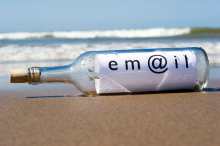Seven rules of e-mailing etiquette which simplifies your e-mailing
Datum: 2011-05-18 13:11

When so much of our daily work-related communication today is conducted by e-mail, this central tool can, if correctly used, be the backbone to good personal structure or, if not utilized optimally, be fatal to our sense of order and structure.
How you adjust your e-mail program settings and how you organize your folders, rules and filing routines in all honor, but when it comes down to it, what really matters is how you actually use the e-mail in your everyday life.
There are no general rules as to how to use e-mailing properly, but mustn’t some form of e-mailing etiquette spontaneously have evolved at some point in time?
If we can find a least common factor in how we e-mail, the communication between us conducted by e-mail will flow smoother and our workday which is filled with e-mails will be made slightly easier to cope with.
If I could be the one to decide, we would follow the following rules when we e-mail:
- Always type something descriptive in the subject line
No, “Hi” alone will not suffice.
We receive such large amounts of e-mails and the sooner we are able to determine what the e-mail is about, the easier it will be to decide on what mail is the right one to prioritize at the moment. - If you start a new conversation, create a new, empty message
Rather than sending a new e-mail to someone you have been in touch with previously by replying to a two month old mail from your recipient, which you found somewhere amongst all the mail that still remains in your inbox, open a fresh message or at least edit the subject line to contain what this particular e-mail is about (rather than “RE: [what the topic of you communication was a while ago]”).
- Always use the common, established rules of writing
Begin every sentence with a capital letter and the text will be easier to read. Formulate sentences so that each contains at least subject and predicate and you will give a good impression.
- If the e-mail is long, divide it into smaller sections diligently
Allow for the individual passages to be shorter than if you had written the letter by hand or with the intention of printing it. Text on a computer screen is often perceived to be harder to read than printed material.
- If you are sending the same e-mail to a larger group of people who do not know each other, use the bcc:-feature rather than the cc:
If you use the cc:-feature, all receivers will see the other e-mail addresses, which might not be appreciated by all included in the list.
Considering how connected most people are today, it is possible to find the e-mail address to virtually anyone present on the web, but unfortunately there are still people who believe that it is OK to send newsletters or e-mail to others with out asking for their permission first, solely due to having gained access to the address in this manner. - If you pose several questions in the same e-mail, number the questions so that it is easy for the receiver to refer each answer to the relevant question
Some are comfortable answering questions which are ”imbedded” in the original e-mail, which are then perhaps quoted in the reply. To me, those answers are much harder to read and comprehend.
E-mail has the characteristics of a walkie-talkie-conversation rather than a telephone-conversation and hence I feel that the form [full, unbroken message] – [another full bodied reply] is more appropriate than the form [full [and an answer to a question] bodied mess[and a comment on something else]age].
- Be brief
It is easier to handle several but short e-mails rather than few yet long ones, since the former are easier to delete soon after reading them while the latter tends to remain in the inbox due to that “there is just one more thing in the e-mail I need to deal with before I can remove it”. These tend to become leavens.
Less time for e-mailing
There. I’ve said it. If we did this, we would be able to spend less time handling e-mails and more time doing what we really are enthusiastic about, what is important for our business and what creates the greatest possibility that we attain our goals.
How do you do it?
What rules of e-mailing-etiquette have I forgotten? Leave a comment to let me and others know.




